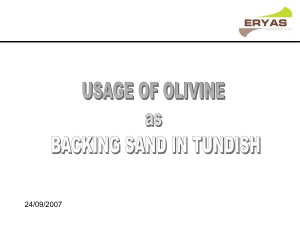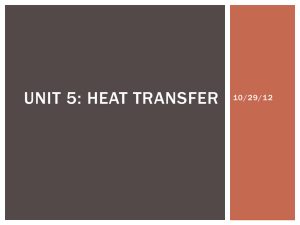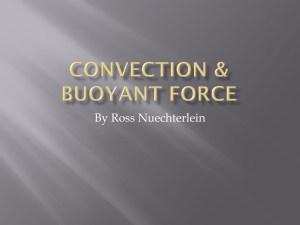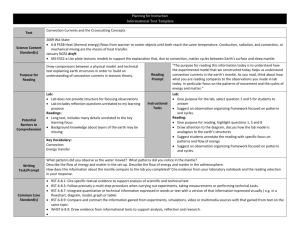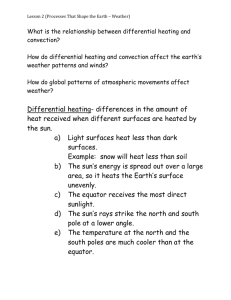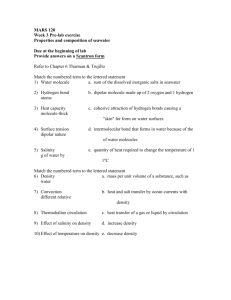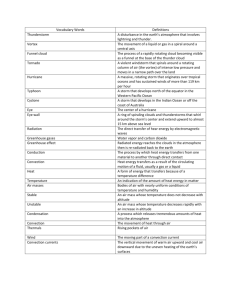Investigation on the convection pattern of liquid steel in the
advertisement
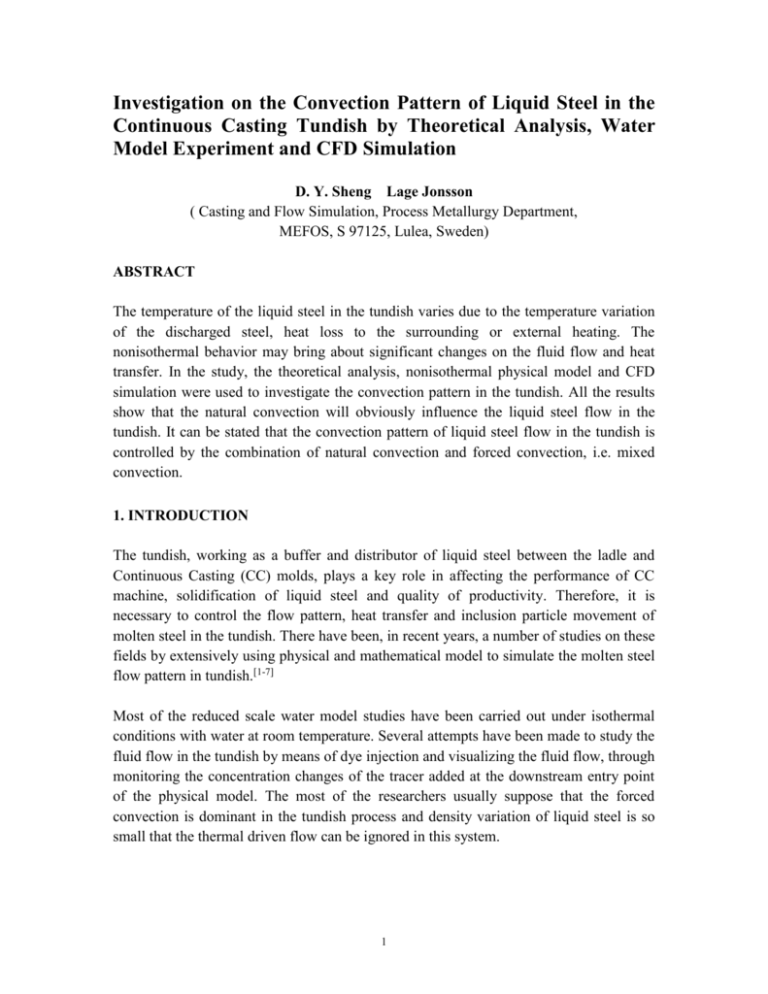
Investigation on the Convection Pattern of Liquid Steel in the Continuous Casting Tundish by Theoretical Analysis, Water Model Experiment and CFD Simulation D. Y. Sheng Lage Jonsson ( Casting and Flow Simulation, Process Metallurgy Department, MEFOS, S 97125, Lulea, Sweden) ABSTRACT The temperature of the liquid steel in the tundish varies due to the temperature variation of the discharged steel, heat loss to the surrounding or external heating. The nonisothermal behavior may bring about significant changes on the fluid flow and heat transfer. In the study, the theoretical analysis, nonisothermal physical model and CFD simulation were used to investigate the convection pattern in the tundish. All the results show that the natural convection will obviously influence the liquid steel flow in the tundish. It can be stated that the convection pattern of liquid steel flow in the tundish is controlled by the combination of natural convection and forced convection, i.e. mixed convection. 1. INTRODUCTION The tundish, working as a buffer and distributor of liquid steel between the ladle and Continuous Casting (CC) molds, plays a key role in affecting the performance of CC machine, solidification of liquid steel and quality of productivity. Therefore, it is necessary to control the flow pattern, heat transfer and inclusion particle movement of molten steel in the tundish. There have been, in recent years, a number of studies on these fields by extensively using physical and mathematical model to simulate the molten steel flow pattern in tundish.[1-7] Most of the reduced scale water model studies have been carried out under isothermal conditions with water at room temperature. Several attempts have been made to study the fluid flow in the tundish by means of dye injection and visualizing the fluid flow, through monitoring the concentration changes of the tracer added at the downstream entry point of the physical model. The most of the researchers usually suppose that the forced convection is dominant in the tundish process and density variation of liquid steel is so small that the thermal driven flow can be ignored in this system. 1 Significant effort has also been devoted by research works on the mathematical modeling of transport processes in tundish. All of these investigations have increased the understanding of the interactions which take place within the tundish and have permitted considerable improvements for steel quality. From previous works, it can be found that some considered the molten steel flow in tundish as the forced convection pattern and ignored thermal buoyancy force[8-11], however, others were opposite[12-15]. Hence, to determine the convection pattern of molten steel flow in tundish is the key point of the present study. According to the characteristics of tundish process, the temperature of liquid steel in the tundish may vary due to the following reasons: a) Heat loss to the atmosphere by conduction through the tundish wall and by radiation through the bath surface b) External heating and cooling when used for regulating temperature and composition in the tundish. c) Variant temperature of liquid steel discharged into the tundish due to temperature variation of ladle stream. Consequently, a non-isothermal situation exists in the CC tundish and the flow patterns in such cases maybe quite different from the those obtained under isothermal conditions. Hence, in this study, the theoretical analysis, water model and CFD simulation were used to investigate the non-isothermal phenomena existed in the tundish. The dimensionless 2 number, Gr / Re , is used as a criterion to determine the convection pattern in tundish system. In addition, the similarity between the actual tundish and water model is also analyzed. A non-isothermal water model experimental apparatus and results are also shown in this paper. Furthermore, PHOENICS (version 3.1) is used for the CFD simulation and the results are verified with measurement. All of the results show the transient and non-isothermal characteristics of the fluid flow and heat transfer processes. The conclusion that can be drawn is that the convection pattern of fluid flow in the tundish is controlled by the combination of natural convection (thermal buoyancy), and forced convection. 2. THEORETICAL CONSIDERATION 2.1 The criterion of convection patterns 2 The convection pattern of tundish system can be determined by the forces exerted on the molten steel. The buoyancy force (Fb) and inertia force (Fi) will give rise to natural convection and forced convection respectively. Therefore, the value of Fb/Fi can manifest the convection pattern of fluid flow in tundish. Considering the ratio of buoyancy force and inertia force, it can be calculated as follows by dimensional analysis, Fb gl 3 ~ Fi u 2 l 2 (1) It’s obviously that the ratio of Fb/Fi is a dimensionless value. Hence, we try to make this value related with some well known dimensionless criterion number. So, the Eq. (1) can be written as Fb ( gl 3 )* ( / 2 ) ( gl 3 / 2 ) ( gl 3 / 2 ) ~ ~ ~ Fi ( u 2 l 2 )* ( / 2 ) ( ul / )2 Re 2 (2) From the definition of thermal expansion coefficient, we can get ~ T (3) Combining with Eq.(2) and Eq.(3), we arrive at Fb ( gl 3T / ( / )2 ) ( gl 3T / 2 ) ~ ~ ~ Gr / Re2 Fi Re2 Re2 (4) 2 Therefore, the dimensionless number, Gr / Re , can be the criterion to determine the convection pattern in tundish system. The next step is to make the order-of-magnitude of this dimensionless number for the primary interests of convection pattern in tundish system. It is obviously as follows Gr / Re2 1 : inertial force dominant fluid flow, forced convection pattern, Gr / Re2 1 : Both inertial and buoyancy force dominant fluid flow, mixed convection pattern, 2 Gr / Re 1 : buoyancy force dominant fluid flow, natural convection pattern, 2.2 Convection pattern of continuous casting tundish 3 In order to study the convection pattern in the actual tundish system, the value of 2 dimensionless number, Gr / Re , could depict whether the temperature variation will have notable influence on liquid steel flow or not. The parameters of liquid steel in tundish can be taken as follows, s 3.9 104 (1/℃ )[13] ; g 9.81 (m/s2); ls 0.6 (m) ; us 0.022 (m/s)[16] 2 Thus, the value of Gr / Re in tundish system will be yielded, ( Gr / Re2 )s ( gl 3T / 2 )s s gTsls 4.74 Ts ( ul / )s 2 us 2 (5) From the result of Eq.(5), even small temperature difference ( T 1 ℃ ) in the vessel 2 gives Gr / Re value of 4.74. Therefore, mixed convection can be deduced in the actual tundish system, where the temperature difference is generally around 15℃. 2.3 Convection pattern of non-isothermal water model Isothermal water model has been extensively used for studying melt flow through tundish. Dynamic similarity criterion is considered to simulate the prototype by reduced scale model. In order to draw the influence of temperature variation, the non-isothermal . ), is taken in this research. To describe water model, with reduced scale factor ( 05 the thermal buoyancy force acting on the fluid, the gravity should be taken into account especially in non-isothermal water model. Hence, Froude number similarity criterion was considered to simulate the prototype by reduced scale model[13]. The dimensionless 2 number , Gr / Re , will be also taken into account. Based on Froude number similarity criterion, Fr u 2 / gl , the following relationships between water model and the actual tundish are considered. Characteristic length lw ls (6) Characteristic velocity uw 0.5 us (7) For non-isothermal water model, the relationship between the density and temperature of water is regressed from the data given in reference[17] . Physical parameters for water are given as follows: w 1004.6 0.3484T (kg/m3) (8) 4 w 348 . 104 (1/℃ ) g 9.81 (m/s2); lw ls 0.3 (m) ; uw 0.5us 0.016 (m/s) 2 Therefore, the value of Gr / Re in the water model can be derived as follows, ( Gr / Re2 )w ( gl3T / 2 )w w gTw l w 4.00Tw ( ul / )w 2 uw2 (9) From the result of Eq.(9), the mixed convection can also be predicted in this nonisothermal water model. Moreover, the non-isothermal water model can be employed to simulate the mixed convection in the actual tundish due to similar of this dimensionless number. 3. EXPERIMENTAL PROCEDURE A single-strand slab caster tundish is applied to study its flow pattern while the temperature of inlet stream changing (higher, equal and lower temperature of inlet stream). A series tests with varying T in the water model has been undertaken. Where, T T1 T2 (10) Here, T1 -- temperature of charged water, representing temperature of liquid steel in the ladle T2 -- temperature of water in the tundish model, representing temperature of liquid steel in the tundish The positions for photographs and continuous measurement of temperature at multi-point are selected to analyze the fluid flow and temperature distribution under the different experimental conditions. A 1/2 reduced scale water model was constructed using plexiglass for the purpose of visualization. The experimental apparatus is shown schematically in Figure 1. The heater was attached to the upper water trunk to generate the temperature difference between upper trunk and tundish water model. The volumetric flow rate was determined by dynamic similarity (using Froude number) with the actual tundish and incoming stream passes through the tundish model (2) and exits through the outlet (3). Fluid flow pattern is observed by the intensity of color trace. 11 thermocouples were inserted in the bath at selected points, one for measuring the temperature of incoming stream (No. 11), the others (No. 1-10) for measuring the tundish bath (See in Fig.1).. The experiments were performed with or without flow control (like dam and weir), meanwhile the different inlet 5 water temperature, flow rates and water bath heights were also taken into account. Important parameters for the water model experiment are given in Table 1. 4. MATHEMATICAL MODEL DESCRIPTION 4.1 Governing Equations The assumptions made for the mathematical model are the following. a) b) c) d) e) The model can be based on a 3-D standard set of Navier-Stokes equations. The standard k- two equations model is used to describe turbulence. The non-isothermal water model is symmetric, i.e. the calculation domain can be simplified. The free surface is flat and kept at a fixed level. The heat exchange between water and air can be ignored. This could be justified due to the small temperature difference and the short simulation time. The liquid flow and heat transfer are governed by both the inertia force and thermal buoyancy force, which means a mixed convection pattern should be considered. According to the above assumptions, the differential equations which describe the liquid flow, turbulence and heat transfer can all be cast into the following format: ( ) div( v ) div( grad ) S (11) t 4.2 Boundary Conditions The inlet velocity and flow rate are set to a constant value determined by the experimental values. The inlet temperature is also set based on experimental values. The relative pressure value is set to zero at the outlet cell surface. Normal gradients of all other variables solved are also set to zero at the outlet. The balance of the flow rate in the inlet and in the outlet is also taken into account. All velocities are set to zero at any wall. A log-law wall function is employed to deduce k, , wall shear stress, and all velocity components parallel to the boundary at the first computational grid point adjacent to this wall. 6 The velocity components normal to planes of symmetry are set equal to zero. For the velocity components parallel to planes of symmetry, the normal gradient is set equal to zero. The flux of all scalar variables, such as T, k and , are set to zero. The free surface of the liquid bath is assumed to be flat and frictionless, i.e., its boundary conditions are the same as those at the symmetry plane. 4.3 Computational Details The solution of the governing equations, boundary conditions, and source terms is obtained by using the CFD software package PHOENICS 3.1[18]. The computational domain is determined based on the water model geometry. The grid generated (501520) is illustrated in Fig.2. The isothermal steady state simulation is done in the first step and its solution is used as the initial field for the full transient simulation. Only the inlet temperature is changed for the different transient runs. The inlet temperature is set according to the experimental values. This method of numerical simulation maintains the same procedure as used in the water model experiments. To get a stable and converged solution, the isothermal steady state calculation needed 10,000 iterations. This required about 10h of CPU time on a SUN workstation. For the transient simulation, convergence for each time-step (5s ) is usually achieved after about 500 iterations. It required about 30h of CPU time for a 5 min transient simulation. 5. RESULTS and DISCUSSION A. Isothermal Flow In the steady state simulation, all the initial fields were set to zero. The volumetric water flow rate at the inlet were set to a constant value of 2000 l/h. The temperature was not solved for and set to a constant value of 283K. The flow patterns predicted without a dam and weir in the longitudinal vertical symmetry plane, containing the inlet and outlet stream, and in the longitudinal vertical plane close to the wall, are shown in Fig.3. The inlet stream hits the bottom with a high velocity, then a part of the stream moves downwards in the direction of the outlet mainly along the side wall. The rest of the stream is recirculated backwards in the direction of the incoming jet. Near the inlet region, a significant recirculating flow is predicted as a result of entrained fluid flowing back to the entrance area. The dead zone, i.e. the lowest velocity region, is located in the upper right hand corner of the vessel. Fig.4 shows the predicted flow patterns in the water 7 model with a dam and weir. The violent turbulent eddies are limited within the inlet region due to flow control introduced by the weir. With the guiding dam, the main stream is forced to flow upwards and a surface flow pattern with lower turbulence is predicted. This flow pattern has significant effects on the floatation of inclusion particles. Nonisothermal Flow Hotter incoming Fig.5 presents the predicted velocity vectors in the symmetry plane after pouring hotter water ( T = +20℃ ) for a period of 60s and 120s respectively. By the thermal similarity analysis, a 20℃ temperature difference in the water is equivalent to a 17℃ temperature difference in the steel system. The steady state flow pattern is set as the initial field. Comparing Fig.3 and Fig.5, in the region apart from the inlet, it can be found that the hotter (lower density) water flows over the cooler and heavier water which leads to the main hotter stream flowing up to the top free surface even without guiding of the dam. The horizontal velocities increase significantly as compared to the isothermal flow case. A strong clockwise recirculation loop is in the right part of the vessel due to the flotation of the hotter incoming stream. This flow pattern is desirable for the purpose of cleaning steel from inclusion particles due to the prolonged distance the particles are moving close to the slag and thus the increased possibility of their absorption by the slag. From the temperature profiles, it is obvious that the temperature field changes mainly follow the movement of the hotter stream, indicating that convective heat transfer is dominant as compared with conductive heat transfer. After pouring hotter water for a period of 120s (Fig.6b), the lowest temperature region, regarded as the dead zone for these experimental conditions, is located near the bottom, approximately in the middle of the vessel. Fig.7 shows the measurements and the corresponding predicted results of the temperature variation versus time at the selected experimental points (No.4,6,9 and 10). Good agreement can be found between the CFD simulation results and measurements. The initial times of temperature variation measured by different thermocouples can reflect the main routine of the hotter stream flowing in the water model. This can be stated that the hotter stream moves along the bath surface (Nos.6) to the upright corner firstly (Nos.10), then flows along the right-side wall to the outlet (Nos.9), finally, it will reach the bottom (Nos.4) . The experimental photos and measurements can also be referred to the previous publications[19,20]. 8 As mentioned above, the experimental results of temperature measurement at different selected points devised that natural convection can not be ignored in the tundish bulk flow. Ten thermocouples are set at the main-section plane, along the central line of inlet and outlet. However, the number of measuring point are always restricted by experimental conditions and setting of many measuring points may influent the flow pattern. If the reasonable points are selected, two dimensional temperature distribution can be derived by the influence of the measured data, which will conveniently and effectively obtain more interesting information in this research system. In this study, the experimental data was interpolated to the whole main-section plane with 8000 grids by using Microcal Origin 5.0. Fig.8 Shows the unsteady 2D experimental temperature profiles with different inlet mass flux. The hotter stream floats up more significantly with the smaller inlet mass flux, as shown in Fig.8a. After the 360 seconds from the pouring, the upper part of model are covered by hotter liquid under the condition of smaller inlet mass flux, which shows large difference in comparison with the bigger inlet flowrate (Fig.8b). As show in Fig.8 , we can draw the conclusion that the difference of inlet flux will influent the convection pattern in the non-isothermal tundish system. Fig.9 shows the influence of bath depth to convection pattern in the tundish system by drawing the 2D experimental temperature profiles. The temperature of shallow bath is higher than that of deep bath. Furthermore, the stratification of temperature profiles is more acute with the increasing of bath depth. This indicates that natural convection is more dominant with increased bath height. Cooler incoming Fig.10a1,a2 and a3 show the transient numerical simulation results for fluid flow and heat transfer at the symmetry plane after pouring cooler water into the water model with the flow control device. It can be seen that the cooler incoming water flows downward after it runs over the dam, then it flows along the bottom to the outlet. Apart from the inlet region, the higher velocity liquid is located near the bottom of the model. The upper part is now almost stagnant. In order to show the heat transfer process more clearly, the colors are filled in for the contours of the temperature fields. The temperature field changes with the mixing of the inlet stream and water originally in the model. In the inlet region, strong mixing will be achieved due to the dominance of the interial force as compared with the buoyancy force. On the contrary, a typical buoyancy driven flow can be found behind the weir. The dead zone, filled with red color in Fig.10a3, occupies most of the upper part of the water model. 9 In Fig.10b1,b2 and b3, the experimental photographs show the transient intensity indicated by dark ink, added into the cold inlet stream. The comparison between these sequential photographs and the predicted contours provides another verification of the mathematical model. A flow control device, such as a dam, is not effective to guide the flow when the cooler water is discharged. In the case that the temperature of inlet stream is lower than liquid steel in the bulk. This indicates that the small inclusion particles in the actual tundish with a dam may lack opportunity to float up and be absorbed by the slag. This might happen during the later period of a ladle teeming process, if big heat losses exist in the ladle. 6. CONCLUSIONS 2 The dimensionless number Gr / Re can be imposed to describe the convection pattern in non-isothermal continuous casting tundish system. The critical parameters of affecting the convection pattern in tundish system is temperature difference T , mean velocity u and the depth of bath l of the liquid steel. By simulating the non-isothermal water model, experimental results show that the temperature variation of inlet stream will affect the flow pattern of molten steel flow in tundish. When pouring the hotter or cooler water into the model without flow control devices, the transient CFD simulation results clearly shows a thermally driven flow pattern, leading to thermal stratification in the bath. The location of the dead zone changed with different thermal conditions. From the results of theoretical analysis, physical and mathematical model simulation, it can be stated that the convection pattern of molten steel flow in tundish is controlled by the mixed phenomena of nature convection and forced convection. ACKNOWLEDGMENT One of the Authors, D. Y. Sheng, would like to express his appreciation to Prof. T. C. Hsiao, Northeastern University, China and Prof. J. K. Yoon, Seoul National University, Korea for their fruitful help and kind encouragement in this work. 10 REFERENCE 1. Y. Sahai, R. Ahuja: Steelmaking Proc., 1986, vol.69, pp.677-687 2 . J.W. Han, K.J. Bai, J.K.Yoon: J. Korean Inst. Met., 1987, vol. 25, pp.778-789 3 . H. Nakajima, F. Sebo, S. Tanaka, L. Dumitru, D.J. Harris, R.I.L. Guthrie: Tundish Metallurgy, Vol. I , Warrendale, PA, pp.101-112 4. J. Knoepke, J. Mastervich: Tundish Metallurgy, Vol. I , Warrendale, PA, pp.113124 5. C.J. Dobson, R. Serje, K. Gregory: Proc. Of 4th International Conference Continuous Casting, 1988,Vol. 2, pp.682-693 6. K. M. Godiwalla, S. K. Sinha, C. S. Sivaramakrishnan: Steel Res., 1994, vol.65, pp.267-272 7. L. K. Chiang: Steelmaking Proc., 1992, vol.75, pp.437-450 8. Y.He and Y.Sahai: Metal. Trans. B, 1987, vol.18B, pp.81. 9. J.Szekely and N. El-kaddah: Steelmaking Proc., 1986, vol.69, pp.761-76 10. S.M.Lee, Y.S.Koo, T.Kang et.al: Proc. 6th Int. Iron & Steel Cong., ISIJ, Tokyo, 1990: pp.239 11. O.J.Ilegbusi and J.Szekely, Mathematical Modeling of Materials Processing Operations, TMS. Warrendale. PA, 1987, pp.409 12. S. Chakraborty , Y. Sahai: Ironmaking and Steelmaking, 1992, vol. 19, pp.479-487 13. M. L. Lowry, Y. Sahai: steelmaking Proc., 1991, pp.505-511 14. Y. Sahai , T. Emi: Proc. Of MSMM'96, 1996, Beijing, pp.323-325 15. D. Y. Sheng , H. Zhang, Y. Gan: Proc. Of MSMM'96, 1996, Beijing, pp.326-332 16. S. Joo, R. I. L. Guthrie: Metal. Trans. B, 1993, vol.24B, pp.755-788 17. Zhang Jiarong, Zhao Tingyuan: Thermal Physical Character Handbook of Common Used Technological Material, 1987.9, [In Chinese] 18. D. B. Spalding et.al: Phoenics Encyclopedia, 1997, CHAM 19. D. Y. Sheng, C. S. Kim, J. K. Yoon and T. C. Hsiao: ISIJ International, 1998, vol.38, pp.843-851 20. D. Y. Sheng, Lage Jonsson: Metal. Trans. B, 1999, vol.30B, pp.979-985 11 Nomenclature Fr Gr g H k Pr Q Re T T t v 0 Froude number Grasholf number acceleration due to gravity, (ms-2) bath height of tundish water model, (mm) turbulent kinetic energy, (m2s-1) Prandtl number flow rate, (l/h) Reynold number temperature, (K) temperature difference, (℃ ) time, (s) velocity of liquid, (ms-1) viscosity, (kgm-1s-1) density, (kgm-3) reference density, (kgm-3) dissipation rate of turbulent kinetic energy (m2s-3) 12
